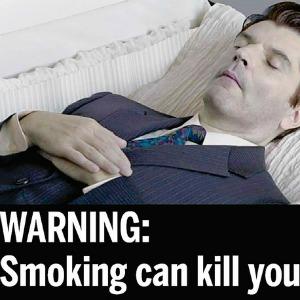BOB GARFIELD: The new CDC ads aren’t the only place you’ll find horrific warnings against smoking. If you bought a pack of cigarettes in the last 46 years, you’ve seen the mandated warnings that say, rather unequivocally, that smoking causes lung cancer, heart disease and emphysema and may complicate pregnancy. Anti-smoking policy has so become the consensus of government and society, that in 2009 the FDA was emboldened to mandate cigarette packaging featuring grisly images in plain view – here a cadaver, here a tracheotomy, here a pair of diseased lungs.
Tobacco companies sued, arguing that they were being refused the basic free speech right not to speak at all. And last month a federal judge agreed. Steve Chapman is a columnist and editorial writer for The Chicago Tribune. He’s written frequently on this issue and recently about this decision. Steve, welcome to the show.
STEVE CHAPMAN: Hi, Bob.
BOB GARFIELD: Tell me first, what law was the basis for the Food & Drug Administration’s rule?
STEVE CHAPMAN: Well, President Obama signed a new law in 2009 which expanded the FDA’s authority over these things, and it gave the FDA the right to require these new warnings, which basically take up half of a cigarette pack and have these big pictures. And his explanation at the time was that the tobacco companies go to great lengths to market to kids, you know, everywhere they play, wherever they live, wherever they shop, and so on, which happens not to be the case.
BOB GARFIELD: Yes, more on that point to follow. But there is some precedent, isn’t there, for compelled speech in package labeling?
STEVE CHAPMAN: The basic idea of regulating commercial speech is that the government has a right to prevent fraud and deception on the part of sellers. If I tell you that I’m the best-looking guy in Chicago, you may or may not believe me but I’ve got a right to say it. But if I tell you that this car I want to sell you has 20,000 miles on it when it’s really got 120,000, that’s a form of theft and that’s what regulation of commercial speech is supposed to prevent.
BOB GARFIELD: Okay now, as to the rationale you alluded to earlier, that the President cited, of counteracting the vast barrage of pro-smoking messages from tobacco companies, you point out in your column that – [LAUGHS] that may have been true ten years ago but not now.
STEVE CHAPMAN: Yeah, when you hear the President talk about this, you kind of think he’s back in the sixties when he started smoking. And the tobacco companies spend very little money on what we think of as advertising anymore. Most of their marketing money goes for price discounts and, and promotions, coupons, things like that. Under an agreement with 46 states that they reached in 1998, the major tobacco companies can’t put up billboards, they can’t put signs up on buses or in trains. They can’t sell apparel that’s got the logo on it. They can’t use cartoon images. They can’t sponsor concerts or NASCAR races, things like that.
Of course, it’s been a long time since they’ve been allowed to advertise on radio or TV. So basically the only time you’ll see a sign advertising cigarettes is if you walk into a gas station or a convenience. And even then, there are restrictions on the size of the signs. When President Obama was a teenager, teenagers could buy cigarettes. Now in every state in the country the minimum age to buy cigarettes is 18 or 19.
BOB GARFIELD: North of the border the government does actually mandate these graphic images. Have they long been on cigarette packs, and how’s that goin’?
STEVE CHAPMAN: They’ve been on cigarette packs since 2001. And cigarette smoking was declining when they mandated those warnings, and it’s continued to decline. And there doesn’t seem to be any effect on youth outcomes, anything like that. There are a lot of countries that have done various types of warnings and restrictions on advertising and so on, and none of it seems to make very much difference, according to the research.
BOB GARFIELD: These facts undercut the President’s argument for why we needed this law that he signed, but the judge was concerned with the separate legal issue of compelled speech. What was the essence of his ruling?
STEVE CHAPMAN: The government has a right to compel speech when it’s providing basic truthful information about a product that’s, you know, relevant to consumers. And in this case, the government really went beyond that and, in fact, the government itself sort of admitted that, and it said, we want to turn every cigarette pack into a mini-billboard to warn against smoking. And it’s pretty obvious that the goal is to disgust people and repel people, and that’s very different from just making sure that people have adequate information to make an informed decision about whether or not they want to take certain risks.
BOB GARFIELD: In your column you applauded Judge Richard Leon’s decision. You quoted the great Supreme Court Justice Oliver Wendell Holmes.
STEVE CHAPMAN: He was actually writing in a case that I believe involved the draft during World War I, and he said the great principle of free speech is freedom for “the thought we hate.” And it’s hard to think of many forms of speech that more people detest than what the tobacco companies put out. And, of course, this decision is going to be appealed and eventually probably the Supreme Court’s gonna have to resolve whether or not this judge got it right or not. I would bet that the Supreme Court will say this law goes too far in compelling speech by the cigarette companies.
BOB GARFIELD: Steve, thanks very much.
STEVE CHAPMAN: Thank you.
BOB GARFIELD: Steve Chapman is a columnist and editorial writer for The Chicago Tribune.

